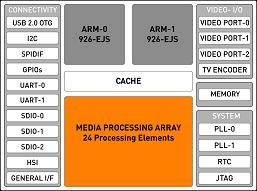Creative's Zii chip - more questions than answers

Over in Las Vegas, Creative is gearing up to launch its Zii. Or perhaps StemCell Computing, or ZiiLABS, or the ZiiLABS ZMS-05 - or all of the above. And they're talking about billion-dollar investments in R&D, building nano-sized supercomputers out of ARM cores, and other exciting but fuzzily defined ideas.
The facts are more prosaic. Zii is a platform - or, as experts call such things, a 'marketing spin'. ZiiLabs is a wholly owned subsidiary, the ZMS-05 is a real chip, and StemCell Computing is what Zii does with the ZMS-05 - or, again according to the experts, 'more marketing spin'.
Let's start with the actual chip. Here it is.

The ZMS-05 is a dual ARM core chip with a 'media processing array' of processing elements which are "basically software defined silicon", says the press release, and various other bits to make it into a complete system. It runs at 10 gigaflops, and can scale up to many petaflops - again, it says here. The company is building a A4-sized Teraflop Accelerator, and promises the potential of 'hypercomputers' 100 times smaller, 100 times greener and 100 times lower cost than conventional supercomputers.
Amazing claims. The data sheet for the ZMS-05 is more down to earth. It reveals the chip to be a 79x54mm package heavily biassed towards embedded video and audio tasks, with lots of video IO, TV generation, USB, flash memory support and all the rest of the stuff you'd want if you were designing a smart set-top box, a portable video player, a connected TV, and so on - not so different in concept to Intel's 'Canmore' CE 3100 device. No power consumption figures are given, nor are there any real details of the 'software defined silicon' aspects, so it's very difficult at the moment to do any form of competitive analysis, or to judge the more exciting claims against reality.
The company does have an evaulation module and a Linux-based SDK ready to roll, though, so if you're really interested there are ways to find out for yourself. Again, the SDK is heavily biassed towards embedded consumer entertainment systems, with lots of video management, photo browsing, camera and audio functions in readymeal format.
The stuff about StemCell Computing, hypercomputers and billion-dollar research investments, however, is probably inspired marketing designed to get yet another embedded media processor chip up and into the spotlight. Looking at Google, you could say that this bit, at least, works quite well.